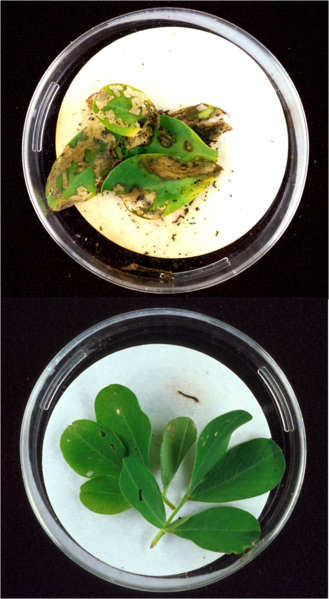Cross-posted from Emily Monosson's Evolution in a toxic world
And another one bites the dust. Corn rootworms, once the scourge of corn growers, stymied by corn engineered to produce Bt toxin (a crystalline toxin that basically pokes holes in the guts of these worms) are back. No matter how you feel about biotech, this is bad news because it can only lead to increased pesticide use.
In his book Lords of the Harvest Journalist Daniel Charles chronicled the early days of Monsanto’s genetic engineering feats. In the beginning, wrote Charles, bioengineers saw themselves as green “revolutionaries”. These were scientists who had come of age during the 1970s and who viewed biology, such as it was, as the answer to agriculture’s chemical addiction. Fears of genetics gone awry aside, biotech could help reign in the large scale use of toxic pesticides. A case in point were plants engineered to express Bt toxin, a pesticide borrowed from Bacillus thuringiensis. Strains of the soil dwelling bacteria (a relative of anthrax bacteria) secrete toxin lethal to certain species of caterpillar, moth, and nematode pests of crops like cotton, corn and potato. Eliminating the need for industrial chemicals, the bacteria have been an “organic” farmer’s friend since the 1920s. For bioengineers, identification of the Bt toxin gene was an opportunity to improve upon nature. Isolated in the early 1980s its discovery, writes Charles, was “too perfect a target for the fledgling biotechnology industry to ignore.”
 By the end of the decade, the first generation of gene jockeys from Monsanto and elsewhere had figured out how to cut and past the Bt toxin gene into laboratory plants. Today the crystalline toxin is expressed in corn, cotton and potato crops grown in the US and around the globe. Today there is controversy over the potential for toxicity to nontarget species and resistance is evolving in target species. But, if pesticide reduction was the goal of Monsanto’s early bioengineers, Bt was a shining example.
Well aware that insects might one day render Bt engineered crops useless by evolving resistance, growers were required to incorporate a block of non-Bt crops where Bt sensitive insects can flourish. A “refuge” of sorts so that sensitive genes continue circulating in the insect populations essentially diluting the influence of resistance.
Unfortunately an idea is only as good as its execution. Refuges were a good idea. But as Brandon Keim explains in his article Voracious worm evolves to eat biotech corn, refuge requirements were lacking, as was the intent of too many growers who ignored the requirement. And as with Roundup resistant crops, the benefits of engineering failed – loved to death by users who, rather than rotating crops to disrupt pest populations kept the pressure on planting in this case, Bt corn after Bt corn after Bt corn. Resistance was inevitable.
[Adapted from Unnatural Evolution: how we are changing the world gene by gene by E. Monosson]
For more see Field Evolved Resistance by Western Corn Rootworm to Multiple Bacillus thuringiensis toxins in transgenic maize by Gassmann et al. PNAS 2014.
By the end of the decade, the first generation of gene jockeys from Monsanto and elsewhere had figured out how to cut and past the Bt toxin gene into laboratory plants. Today the crystalline toxin is expressed in corn, cotton and potato crops grown in the US and around the globe. Today there is controversy over the potential for toxicity to nontarget species and resistance is evolving in target species. But, if pesticide reduction was the goal of Monsanto’s early bioengineers, Bt was a shining example.
Well aware that insects might one day render Bt engineered crops useless by evolving resistance, growers were required to incorporate a block of non-Bt crops where Bt sensitive insects can flourish. A “refuge” of sorts so that sensitive genes continue circulating in the insect populations essentially diluting the influence of resistance.
Unfortunately an idea is only as good as its execution. Refuges were a good idea. But as Brandon Keim explains in his article Voracious worm evolves to eat biotech corn, refuge requirements were lacking, as was the intent of too many growers who ignored the requirement. And as with Roundup resistant crops, the benefits of engineering failed – loved to death by users who, rather than rotating crops to disrupt pest populations kept the pressure on planting in this case, Bt corn after Bt corn after Bt corn. Resistance was inevitable.
[Adapted from Unnatural Evolution: how we are changing the world gene by gene by E. Monosson]
For more see Field Evolved Resistance by Western Corn Rootworm to Multiple Bacillus thuringiensis toxins in transgenic maize by Gassmann et al. PNAS 2014.

Bt toxins present in peanut leaves (bottom image) protect it from extensive damage caused by Lesser Cornstalk Borer larvae (top image).Jan Suszkiw (November 1999.). “Tifton, Georgia: A Peanut Pest Showdown”. Agricultural Research magazine. Archived from the original on 12 October 2008. Retrieved 2008-11-23.


